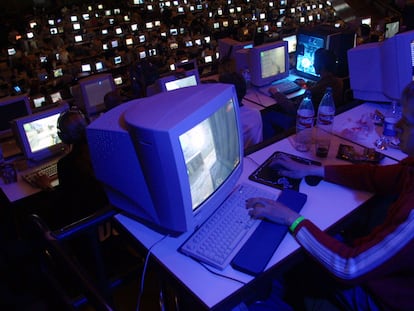Hahaha, LOL or 555: How laughter on the internet is evolving
Neuroscientists, biologists and philologists are investigating whether laughing virtually retains the ability to release endorphins, reduce stress and foster social bonds, its effects in person

In analog life, an adult person laughs about 15 times a day. But if we could read all their virtual interactions, we would think we were in front of a clown, a maniac or a child (minors laugh about 400 times a day). The little face crying with laughter 😂 is the most used emoji on Apple, on Facebook, even on X. Everyone on the internet always claims to be dying of laughter. If that were true, rush hour on the subway would be a carousel of guffaws rather than silent people with their gazes buried in their cell phone. Instead of funny, it would be a terrifying sight.
Fortunately, what we say on the Internet should not be taken literally. We may be exaggerating. In an article in The Conversation, professors Benjamin Nicki and Christopher Muller estimated that there’s an 85% chance that a virtual interlocutor will respond with an emoji of a face crying with laughter to any comment he or she finds remotely funny. A Columbia University study analyzed 45,000 text messages from young adults: 14% contained the expression LOL (laughing out loud). Another study, from the journal American Speech, noted that this expression had come to be used “as a signal of speaker involvement, just as one might say ‘mm-hm’ in the course of a conversation.”
Many experts agree that haha, LOL and 😂 transcend humor to express something more. When it occurs in the analog world, laughter releases endorphins, relieves stress and serves to create bonds between people. It is an evolutionary advantage and plays a role for other species of social animals. But there are few studies that analyze whether laughter’s virtual counterpart has the same effect. And it makes more and more sense to find the answer, as memes have replaced oral jokes, and many jobs are performed remotely and the only interaction among colleagues takes place in a WhatsApp group.
In recent years, we have moved our conversation to the online world. Oral words have been transformed into written ones, losing some information (intonation, accent, etc.) along the way but keeping their essence and meaning. The same is not true of laughter, a different form of expression that involves other neural mechanisms, that occurs spontaneously in a social context and is difficult to transfer to paper or screen. And yet, as soon as we go on our phones or computers, we can’t stop laughing.
Laughter—along with crying and screaming—is one of the few sounds we use to communicate before we speak. It also predates language at an evolutionary level. Before the first hominids invented words, they were already laughing together. Laughter is not exclusive to humans. Rats laugh, meerkats laugh, great apes laugh in a way that is very similar to the way we do. Michael Brecht, a neuroscientist at Humboldt University in Berlin, has been studying how this laughter occurs in animals for years. So far he knows where the laughter is produced. His team points to the periaqueductal gray matter, a cluster of neurons located around the midbrain, as published in a study in the journal Neuron.
Animal laughter and contagious laughter
“Vocalizations like laughter are very important in play,” Brecht explains. When animals play, laughter coordinates and directs the process. It serves as an acknowledgment of humorous intentionality. It makes the difference between a fight and a game; a hunt and a game of tag. This also works with humans. Laughter turns a politically incorrect comment into a joke; it is the intentionality that disarms a threat. Perhaps that is why, in an online environment, where we are robbed of non-verbal context—of smiles, intonations and looks—it is more necessary to point out the humorous intentionality of our words.
Brecht also believes that emojis and onomatopoeias serve to channel humor. “Humans have this ability for symbolism, and I think we get a lot out of symbols,” he says. Don’t forget that humor has a social component, and seeing—or reading—another person laughing can be contagious. Laughter is 30 times more likely to occur in the company of others. Perhaps that is why several studies have found that people tend to laugh more when talking to friends than when watching television or reading books alone.
This is something television producers also know. “That’s why, when we watch comedy shows, they introduce that canned laughter every time there’s a joke,” Brecht explains. “It’s surprising, but it works; it helps people laugh.” One study, published in the journal Current Biology, claimed that even bad jokes were funnier if they were acoustically highlighted with canned laughter; but for this contagion effect to work, it must sound spontaneous, authentic. Something similar happens in online conversations.
Laughter is universal, unless you try to express it in writing. “There tends to always be a similar pattern, it consists of repetition, but it differs a lot between languages,” Lezandra Grundlingh, an expert in literature at the University of South Africa who has researched the implications of written laughter in different languages, explains in an email exchange. “This repetition can consist of vowels and consonants [hahaha in English; jajaja in Spanish; xaxaxaxa in Greek], a repetition of consonants only [kkkkk in Portuguese; wwwww in Japanese], or a repetition of numbers [555 in Thai or 233 in Chinese]. These types of repetitions are used to imitate the sound of laughter,” the expert points out.
The anatomy of an emoji
But the way we laugh online doesn’t just tell you where we’re from. It also gives a clue as to how old we are. “Like many aspects of language, the use of emojis, initialisms and written forms of laughter is constantly evolving,” explains Grundlingh. According to an analysis of 700 million comments on the English-language forum Reddit, the expression LOL went from accounting for 30% of laughs in 2009 to 60% in 2019: LMAO (another acronym, which stands for laughing my ass off) has also increased, albeit less dramatically, while the traditional hahaha has dropped slightly, from narrowly exceeding 30% of online laughs in 2013 to under 19% in 2019. In recent months, videos of young people from generation Z lamenting millennials’ use and abuse of the emoji of the little face crying with laughter have gone viral on TikTok. Among the youngest generation, the skull, 💀, is used as a graphic reflection of the expression I’m dying laughing.
“The use of specific forms of communication is definitely linked to specific age groups. That underscores the link between language and identity. People who continue to use expressions that we might now consider old-fashioned do so because it is part of their linguistic identity in a particular language,” says Grundlingh.
Barbara Plester is a lecturer at Auckland University and co-author of Laugh Out Loud: A User’s Guide to Workplace Humor. She researches laughter from a cognitive and behavioral point of view, particularly its role in the workplace. According to her research, people who know how to tell a good joke are often considered more competent at work. “Humor helps relieve tension and stress. It also helps to bond with co-workers and can even be used to safely express resistance to a boss’s order or directive,” Plester explains.
From joke to offense
The researcher adds that humor often pushes the limits of what is socially acceptable, so in a work context “it can offend and annoy colleagues.” In such cases, the fact that it is in writing, in the absence of gestural information, the impossibility of seeing how colleagues react to the joke can exacerbate susceptibilities.
In 2005, evolutionary biologists David Sloan Wilson and his colleague Matthew Gervais explained the evolutionary benefits of humor in the Quarterly Review of Biology. Both are proponents of group selection, an evolutionary theory based on the idea that, in social species such as ours, natural selection favors characteristics that promote the survival of the group, not just individuals. Laughter is one of these characteristics.
Wilson and Gervais note that there are two different types of human laughter: spontaneous, emotional and involuntary laughter, as a reaction to play and jokes; and non-spontaneous laughter, a studied and unemotional imitation of the former. People employ it as a voluntary social strategy; for example, when smiles and laughter punctuate ordinary conversations, even when they are not particularly funny, for example, when we say in a chat room that we are laughing out loud, despite the fact the comment may not have elicited even a faint smile.
Humans have been writing jokes since at least the 4th century, when The Philogelos became the first humorous compilation in history. It is not reading’s ability to make us laugh that is in question, but rather whether the social component of laughter can be eliminated in the physical or virtual world. Michael Brecht sees it as impossible and believes that, even in the virtual environment, we tend to laugh in the company of others. “That’s why, when you see a particularly funny meme, the first thing you do is try to show it to more people. Because the essence of laughter is the social, the shared,” he concludes.
Sign up for our weekly newsletter to get more English-language news coverage from EL PAÍS USA Edition
Tu suscripción se está usando en otro dispositivo
¿Quieres añadir otro usuario a tu suscripción?
Si continúas leyendo en este dispositivo, no se podrá leer en el otro.
FlechaTu suscripción se está usando en otro dispositivo y solo puedes acceder a EL PAÍS desde un dispositivo a la vez.
Si quieres compartir tu cuenta, cambia tu suscripción a la modalidad Premium, así podrás añadir otro usuario. Cada uno accederá con su propia cuenta de email, lo que os permitirá personalizar vuestra experiencia en EL PAÍS.
¿Tienes una suscripción de empresa? Accede aquí para contratar más cuentas.
En el caso de no saber quién está usando tu cuenta, te recomendamos cambiar tu contraseña aquí.
Si decides continuar compartiendo tu cuenta, este mensaje se mostrará en tu dispositivo y en el de la otra persona que está usando tu cuenta de forma indefinida, afectando a tu experiencia de lectura. Puedes consultar aquí los términos y condiciones de la suscripción digital.
More information
Archived In
Últimas noticias
Most viewed
- Pablo Escobar’s hippos: A serious environmental problem, 40 years on
- Why we lost the habit of sleeping in two segments and how that changed our sense of time
- Charles Dubouloz, mountaineering star, retires at 36 with a farewell tour inspired by Walter Bonatti
- Reinhard Genzel, Nobel laureate in physics: ‘One-minute videos will never give you the truth’
- The Florida Keys tourist paradise is besieged by immigration agents: ‘We’ve never seen anything like this’











































